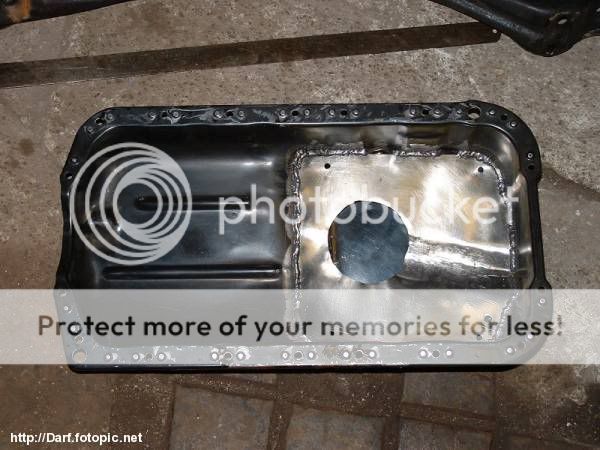ok if the baffle was sealed round the edges with a large opening in the middle above the pickup it''d work like this:
when driving straight and level, the returning oil would gather on top of the baffle plate and gets sucked through the single hole and fills up the baffled chamber (since the chamber is sealed with two openings, the pump sucks oil out of the chamber via the pickup and the vacuum causes the pool of returning oil above to be sucked into the chamber to fill the void).
when turning left or right abruptly the g-force tries to tilt the oil to one side.
as the fluid is being forced diagonally rather than straight down with gravity, the large opening in the middle is now like the open top of a liquid container, determining the highest level of the liquid surface while the excess fluid simply overflows over the lip into a lower level.
with the surface of the fluid brought closer to the pickup, also gradually getting lower as the pump quickly drains the chamber yet the returning oil above can't easily flow back through the middle hole due to g-forces, it could potentially starve the pickup
To keep the fluid level above the pickup, a solution could be to have a fully sealed baffle chamber with a set of horizontal one-way trap-doors at both ends that only allows gas/fluid to flow into the chamber.
the trap doors are horizontal in order to keep as much oil in the baffled chamber.
when straight and level, both trap doors naturally drop open and allows the returning oil above to be sucked into the chamber
when turning abruptly, the oil inside tries to push its way out via the trap doors. the pressure of the flow moves the door till it closes against the baffle and seals, preventing the chamber from losing anymore oil and as a result keeps the oil level much higher above the pickup.
as a result, this provides more time before the level gets too low and starves the pickup.
meanwhile, the opposite door experiences vacuum into the chamber and stays open to allow any oil or air above to enter freely as the pump empties the chamber.
the first design of the trapdoor was this bent bracket but the lip edge of the flap, which is suppose to stop it opening to far, seemed vulnerable to fatiguing and bending up after a number of sudden openings and fail.
the second design was a simpler plate trap-door with a vertical cutout plate that stops it opening too far, which could also be part of the vertical baffle plates
prob need to position more trap doors on the front and back to handle acceleration, braking as well as turning forces.


